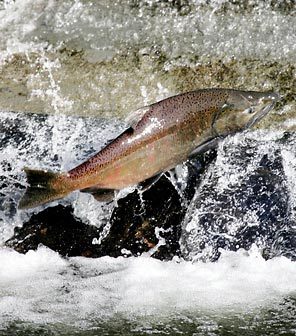forum
library
tutorial
contact

Proposed Salmon-treaty Changes would Allow
More Chinook to Return to Washington Rivers
by Warren CornwallSeattle Times, May 22, 2008
|
the film forum library tutorial contact |

|
Proposed Salmon-treaty Changes would Allow
by Warren Cornwall |
 The proposed version of the Pacific Salmon Treaty would save an additional 1 million Washington-born chinook over 10 years, according to Jeff Koenings, director of the Washington Department of Fish and Wildlife and a lead U.S. representative in the negotiations.
The proposed version of the Pacific Salmon Treaty would save an additional 1 million Washington-born chinook over 10 years, according to Jeff Koenings, director of the Washington Department of Fish and Wildlife and a lead U.S. representative in the negotiations.
"With this agreement, we make a substantial down payment in our efforts to return Washington's weak wild-chinook-salmon populations back to sustainable levels," said Koenings, who chairs of the Pacific Salmon Commission, which oversees the treaty and negotiated the amendments.
The new terms still must be signed by the Canadian and U.S. governments. But because it's a change to the rules, rather than the treaty itself, it doesn't need Congressional approval, Koenings said.
The treaty was first signed in 1985. Under the proposed changes, fishermen in Southeast Alaska would see a 15 percent cut in how many chinook they could catch, and fishermen in Canadian waters off the west coast of Vancouver Island would see a 30 percent cut.
To make up for those lost fish, the negotiators are calling for Congress to allocate $30 million to Canada and $7 million to affected Alaskan interests.
The relatively low-key negotiations are a stark contrast to the past, when the question of who can catch which Pacific salmon triggered fiery rhetoric, protests and diplomatic confrontation between the U.S. and Canada.
At the heart of the problem are salmon that defy political boundaries, spawning in one country's rivers but migrating into ocean controlled by another.
Canadians in the past have complained that Alaskan fisherman catch too many fish bound for Canadian rivers, while U.S. officials objected that Canadian fisherman haul in too many salmon bound for U.S. waters.
In the 1990s, the last time the treaty was renegotiated, tempers grew so hot that Canadian fishermen blockaded an Alaska ferry terminal for days, and Canadian authorities seized several U.S. fishing boats in Canadian waters.
The 1999 listing of Puget Sound chinook, and continued problems recovering Columbia River chinook protected under the federal Endangered Species Act, put further pressure on the treaty.
In 2005, several U.S. environmental groups sued in federal court, charging that as much as 88 percent of chinook caught off the west coast of Vancouver Island came from U.S. rivers, with many of those fish protected under the Endangered Species Act.
The new rules under the treaty put a new emphasis on salmon protection, and less on divvying up who gets to catch the salmon, said Koenings.
The growing sense of urgency about declining Pacific salmon runs helped create a more cooperative mood, and a new focus on letting more fish reach their rivers, he said.
Gov. Christine Gregoire enthusiastically endorsed the new approach, included the reduced catches.
"If we don't work together to conserve, we won't really have anything to allocate in the future," she said.
learn more on topics covered in the film
see the video
read the script
learn the songs
discussion forum
